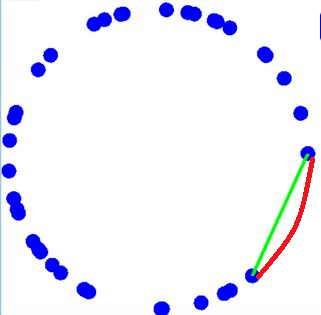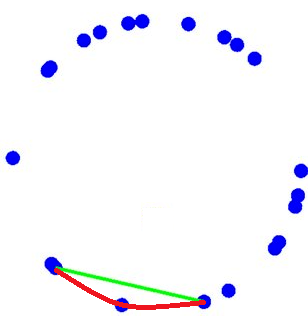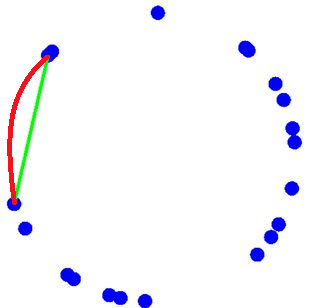5
1
The challenge here is to find the longest uninterruped arc around a unit circle with a random amount of points distributed in random positions around it.
Here is a diagram to assist my explanation:

The red line indicates the largest arc between any two points that is not interrupted by any other points. The challenge is to find the two points on either end of the red line. The green line is simply the straight line distance.
A clarification about what interrupted means: When drawing an arc around the edge of the circle (the red line), this arc should not be intersected by any other point.
Here is a template for the function in C#:
int[] FindPair(double[][] points)
{
return new[]{ 0, 1}; //Find the indices of the two points
}
The function should return two integers, the indices of the two points on either end of the green line.
Assumptions:
- The Length of the points array is arbitrary but more than two. In the example we have:
points[40][] - Each element of the points array contains the x, y position of the point, for example:
points[i] = {x, y} - You can assume that the distance of any given point to the origin at the centre of the circle is always 1.
Notes:
- The answer with the smallest Big O algorithm complexity wins. In case of a tie, shorter code wins.
- Bonus points for the solution to have the ability to work in more dimensions than two.
- I do have a solution, but it is very computationally expensive and only produces the correct answer around 99% of the time.
- I am not sure if the problem has a name in mathematics, or a generally accepted solution. If anyone knows of a better name for this problem so that I can have a better title, that would be helpful.
Points: {
{ -0.71997 , -0.69400 },
{ 0.88564 , 0.46437 },
{ 0.78145 , -0.62397 },
{ 0.98409 , -0.17765 },
{ 0.88220 , 0.47087 },
{ 0.69938 , 0.71475 },
{ -0.89036 , -0.45526 },
{ -0.70588 , -0.70833 },
{ 0.70507 , 0.70914 },
{ -0.34971 , 0.93686 }
}
Solution:
{6, 9}
Points: {
{ -0.71038 , 0.70382 },
{ 0.04882 , 0.99881 },
{ -0.53250 , -0.84643 },
{ -0.86814 , -0.49632 },
{ 0.97588 , -0.21829 },
{ 0.73581 , -0.67719 },
{ 0.88413 , -0.46724 },
{ -0.28739 , -0.95781 },
{ -0.68325 , 0.73019 },
{ 0.91879 , 0.39475 },
{ 0.65335 , 0.75706 },
{ -0.21009 , -0.97768 },
{ -0.94542 , -0.32585 },
{ 0.83207 , -0.55467 },
{ 0.99482 , 0.10170 },
{ 0.86228 , 0.50643 },
{ 0.98017 , 0.19817 },
{ 0.67520 , 0.73763 },
{ -0.03982 , -0.99921 },
{ -0.57624 , -0.81728 }
}
Solution: {0, 12}
Invalid example:

This is invalid, because when drawing an arc around the edge of the circle (the red line) between the two points connected by the green line, this arc is intersected by another point.


2
Welcome to PPCG! This question might get closed because this community is quite strict about the standards for winning conditions. But I hope you stick around and set more challenges! You are strongly encouraged to try them out in the sandbox, to get feedback before posting them on the main site.
– Nathaniel – 2018-05-13T13:47:54.260@Nathaniel: I completely understand, please let me know if there is anything I can do to improve the winning conditions. – Karl – 2018-05-13T13:55:30.493
@Karl The only case that the arc is "interrupted" is the arc is larger than 180°, in that case just discard the arc. (<-- initially I overlooked that part because none of the test cases have such an "arc", but that can be checked in linear time) – user202729 – 2018-05-13T13:59:17.203
1@Karl I believe that a good number of coders on the site would come up with an optimal solution almost instantly for this specific problem, making it largely a race to post first. – xnor – 2018-05-13T15:06:06.063
I have added code-golf to the precedence. If I am proven wrong, and an optimal solution is easy to find then we can golf the optimal solution. But I still think the computational complexity is a challenge in itself. – Karl – 2018-05-13T15:13:29.127
Complexity is O(n) if you read similar problem, so it's mainly a code-golf; but is it [tag:fastest-code] or [tag:restricted-complexity]? – l4m2 – 2018-05-13T15:18:32.167
@l4m2: What is the similar problem? If you can give an answer in O(n) I would be very impressed. It would not be fastest-code but rather fastest-algorithm and then code-golf. – Karl – 2018-05-13T15:23:21.740
@user202729: Yes that would be valid. You can assume the input will always have 2 or more points. – Karl – 2018-05-13T15:42:57.783